The global ambulatory polysomnography systems market is projected to grow from USD 324.48 million in 2025 to USD 543.84 million by 2035, reflecting a CAGR of 5.3% over the decade. Demand is being driven by a shift from traditional sleep-lab testing to home-based sleep diagnostics, which offer improved patient comfort, flexibility, and overall access to sleep disorder detection.
In June 2025, Onera Health launched its patch-based Type II PSG system at the 39th Annual Sleep Meeting in Seattle. The system was presented in four research tracks as "integral to expanding access to gold-standard PSG sleep testing”. Its wireless, adhesive design supports overnight use in home settings. The lightweight patch eliminates cumbersome cabling and enhances patient compliance. Hospital-grade test accuracy has been confirmed in clinical validations.
Recent innovations have also focused on adding AI-driven software for automated sleep staging and real-time respiratory event detection. Major developers like Philips and Natus Neurology have introduced smart systems equipped with ML algorithms that can alert clinicians to anomalies instantly. This reduces manual scoring time and supports remote diagnostics, aligning with the broader trend of telehealth integration in sleep medicine.
Geographic insights reveal that North America remains the leading market. The region’s dominance is fueled by high clinical awareness of sleep disorders, expanded insurance coverage, and strong homecare infrastructure. Meanwhile, Europe continues to grow steadily, led by adoption in countries such as Germany and the UK, which are integrating portable PSG systems into home-testing protocols. The Asia-Pacific region is set to record the fastest expansion. Growth in China, India, and South Korea is being supported by increasing urbanization, rising respiratory disorder awareness, and adoption of remote healthcare technology.
Cost reduction and regulatory support are bolstering market adoption. Manufacturers are addressing affordability and convenience with compact, auto-setup devices. New regulatory guidelines have made home sleep testing more accessible, further accelerating deployment. Pandemic-induced telehealth growth has also raised awareness of contact-free diagnostics, contributing to the mainstreaming of ambulatory PSG systems.
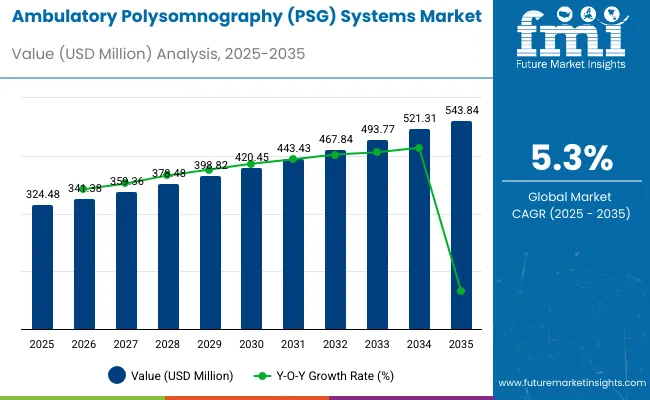
| Attributes | Description |
|---|---|
| Estimated Ambulatory Polysomnography (PSG) Systems Market Size (2025E) | USD 324.48 Million |
| Projected Ambulatory Polysomnography (PSG) Systems Market Value (2035F) | USD 543.84 Million |
| Value-based CAGR (2025 to 2035) | 5.3% |
Sleeping disorders are on the rise globally, affecting a significant portion of the population and leading to serious health implications if left untreated. Conditions like insomnia and sleep apnea are becoming increasingly common, highlighting the urgent need for effective diagnostic solutions. In response to this growing concern, there is a noticeable surge in the demand for Ambulatory Polysomnography (PSG) systems. These portable and efficient devices enable sleep monitoring outside of traditional clinical environments, making diagnosis more accessible and convenient for patients.
Leading companies in the ambulatory PSG market are incorporating smart technologies such as AI-powered data analysis, wireless connectivity, cloud-based platforms, and wearable form factors. These innovations improve diagnostic accuracy, patient comfort, and data accessibility, making sleep studies more efficient for both clinicians and patients.
The global ambulatory polysomnography (PSG) systems market's compound annual growth rate (CAGR) for the first half of 2024 and 2025 is compared in the table below. This analysis offers valuable insights into the industry's performance, highlighting significant shifts and trends in revenue generation.
The first half (H1) is the period from January to June, and the second half (H2) is July to December. In the first half (H1) of the decade from 2024 to 2034, the business is predicted to surge at a CAGR of 6.4%, followed by a slightly lower growth rate of 6.0% in the second half (H2) of the same decade.
| Particular | Value CAGR |
|---|---|
| H1 | 6.4% (2024 to 2034) |
| H2 | 6.0% (2024 to 2034) |
| H1 | 5.3% (2025 to 2035) |
| H2 | 4.9% (2025 to 2035) |
Moving into the subsequent period, from H1 2024 to H2 2034, the CAGR is projected to decrease slightly to 5.3% in the first half and remain relatively moderate at 4.9% in the second half. In the first half (H1) the industry witnessed a decrease of 110 BPS while in the second half (H2), the industry witnessed a decrease of 110 BPS.
The ambulatory polysomnography systems market is expanding as demand grows for portable sleep monitoring solutions. In 2025, up-to 24 channel PSG systems are projected to lead with a 36.6% market share, while obstructive sleep apnea remains the top application, holding 31.6% share. Rising awareness of sleep disorders and advancements in home-based diagnostics are driving this growth.
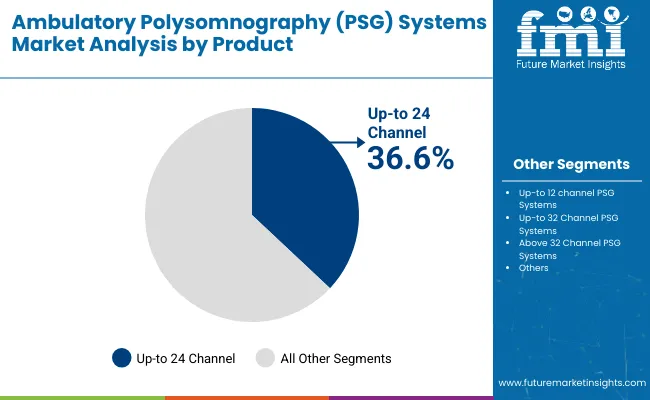
Up-to 24 channel PSG systems are projected to capture 36.6% market share in 2025, dominating the ambulatory polysomnography systems market. These systems offer a balanced trade-off between comprehensive sleep data and patient comfort. Their portability enables home-based sleep studies, improving access to diagnostic services for patients unwilling or unable to visit sleep labs.
These devices record key parameters such as EEG, EOG, EMG, ECG, airflow, and oxygen saturation, enabling robust diagnosis of sleep apnea, insomnia, and periodic limb movement disorders. The segment is gaining momentum as healthcare providers adopt cost-effective alternatives to in-lab PSG testing.
Companies like Compumedics, Natus Medical, Cadwell Industries, and SOMNOmedics are leading innovation with wireless, wearable, and AI-enabled PSG devices. Trends toward remote patient monitoring and telehealth integration further reinforce the demand for up-to 24 channel PSG systems, positioning them as a preferred solution in the market through 2035.
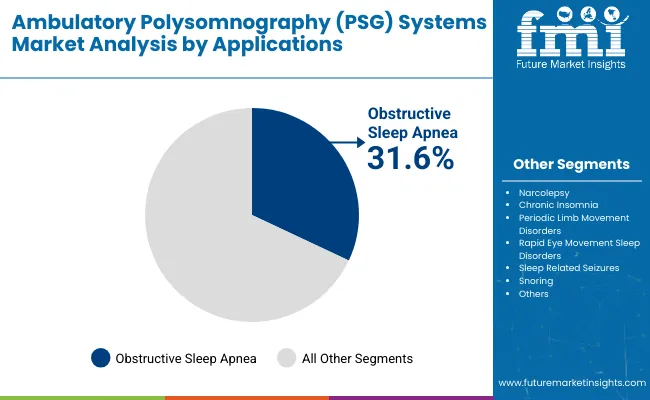
The obstructive sleep apnea (OSA) segment is expected to dominate, with a 31.6% share of the ambulatory polysomnography systems market in 2025. OSA remains the most prevalent sleep disorder globally, and ambulatory PSG systems are increasingly deployed to enable early detection and management. Ambulatory PSG offers a patient-friendly and cost-effective diagnostic pathway, particularly for mild to moderate OSA. Rising awareness of the link between OSA and cardiovascular disease, diabetes, and stroke has driven demand for wider screening.
Leading companies such as Philips Healthcare, ResMed, Nihon Kohden, and SOMNOmedics provide solutions tailored for home-based OSA monitoring. Adoption is rising in both public healthcare programs and private sleep clinics, where reducing diagnostic bottlenecks is a priority.
The OSA segment is also seeing growth due to corporate wellness initiatives, targeting employees at risk of sleep-related health issues. With increasing focus on population health management, demand for ambulatory PSG systems for OSA diagnosis will continue to rise steadily through 2035.
Rising prevalence of sleep disorders drives the market growth
The main factor increasing the demand for ambulatory PSG systems is the growing prevalence of sleep disorders, especially sleep apnea. The American Academy of Sleep Medicine estimates that millions of Americans remain undiagnosed, thus suffering serious health complications if untreated.
As awareness of the consequences of poor sleep such as cardiovascular issues, impaired cognitive function and others grows, individuals are more inclined to seek diagnostic solutions. Ambulatory PSG systems are convenient, accessible, and allow the patients to do sleep studies in the comfort of their homes.
This trend meets the need for diagnosis as well as aligns with the growth of personalized health. Thus, by offering an earlier diagnosis and management of sleep disorder cases, Ambulatory PSG systems play an important role in improving the patients' outcomes and improving public health generally, thus driving the adoption in the market.
For instance, data published on May 8, 2024, by the National Council for Aging indicates that approximately 39 million UNITED STATES adults have obstructive sleep apnea (OSA). Additionally, around 936 million adults worldwide are affected by mild to severe OSA.
Usage of artificial intelligence in PSG systems act as future growth opportunity for the industry growth
Recently, artificial intelligence (AI) has been increasingly integrated into healthcare, enhancing digitalization efforts. It expands digitalization in several ways: for example, sleep diagnostics applies AI to increase both accuracy and speed in home-based sleep testing, hence making home-based tests more cost-effective. This growing trend for home sleep tests inspires manufacturers to use AI.
Traditionally, analysis of PSG data included manual reviews of the complex metrics associated with brain activity, eye movements, and heart rate, which is considered very time-consuming and generally riddled with errors.
AI algorithms can rapidly analyze large volumes of sleep data, then identify patterns and anomalies far more effectively than previously possible by manual means. These automations provide better diagnostic precision because they minimize human error and provide greater consistency and reliability of the results.
Most importantly, AI detects minute variations in sleep patterns that might be missed by human analysts, leading to the diagnosis of sleep disorders like sleep apnea and insomnia with greater accuracy. Integration of artificial intelligence and machine learning in PSG systems provides manufacturers with the opportunity to offer next-generation technology with advanced performance, superior clinical outcomes, and an edge over competitors.
Increasing adoption of wearable sleep testing devices is a major trend in the market
The rise of wearable devices for health monitoring is significantly shaping the design and functionality of ambulatory polysomnography (PSG) systems. With consumers increasingly becoming interested in smartwatches and wearablefitness trackers that monitor sleep patterns, heart rate, and other metrics, a demand is shaped for PSG systems that can provide similar features. This encourages manufacturers to fit advanced sensors with user-friendly interfaces that make sleep studies even easier and more convenient.
Wearable technology-like features, which include mobile app connectivity and real-time data analytics, are being incorporated into PSG systems, making them increasingly user-friendly and appealing.
This kind of advancement in PSG will boost patient engagement and compliance and also offer healthcare providers a number of advantages in regard to remote monitoring and seamless sharing of data. There is little doubt that further evolution of PSG systems-ones offering comprehensive sleep assessment and widening their market presence-will result with further development in wearable technology.
Low awareness among the masses may restrict market growth
Sleep apnea and related disorders are closely linked with increased risks for other disorders, including diabetes and cardiovascular disorders, respectively. Poor sleep can affect metabolic processes and cardiovascular health; one of the consequences is an increased risk for diseases such as hypertension, heart disease, and insulin resistance.
Most people in the general population, particularly those living in the countryside, have little idea about the serious consequences arising from sleep apnea that has not been treated. Chronic health problems, such as heart failure and stroke, high blood pressure, diabetes, and obesity, may be the possible results of sleep disorders if they are not treated. These can also increase many serious health problems, including uncontrolled blood pressure.
Serious health complications may be caused due to untreated sleep disorders, thus heart failure, heart attack, weak and narrow vessels of the kidneys, and aneurysms could occur. The general lack of awareness about sleep disorders among the major fraction of population may restrain the growth of the ambulatory PSG systems market in future.
Many patients of sleep apnea may not differentiate sleep disorders from normal snoring and generally are seen to prefer symptomatic treatment to comprehensive diagnosis. This unawareness together with a symptom-based approach is likely to hamper the development of the ambulatory PSG systems market.
The global ambulatory polysomnography (PSG) systems industry recorded a CAGR of 3.7% during the historical period between 2020 and 2024. The growth of ambulatory polysomnography (PSG) systems industry was positive as it reached a value of USD 543.84 Million in 2035 from USD 324.48 Million in 2025.
Traditional sleep testing includes in-lab PSG, where patients will be spending the night at a sleep clinic. They are hooked up to numerous sensors monitoring the patients' brain waves, oxygen levels, heart rate, and breathing patterns that give detailed information about sleep disorders.
In contrast, in recent methodology, ambulatory PSG or home sleep testing allows the patients to diagnose sleep studies within their comfort zone using portable devices. This is less invasive, much more convenient, and cost-effective, although the data obtained might not be as comprehensive as that from traditional in-laboratory methods.
Ambulatory PSG systems have huge financial benefits compared to traditional in-laboratory studies of sleep. For instance, patients avoid costs related to facility fees during hospital stays, plus other costs for healthcare professionals. With home-based testing, they also eliminate travel costs and time away from work.
Ambulatory PSG for healthcare providers reduces overhead costs, allowing for more streamlined operations and higher patient throughput. Moreover, the reimbursement rates for home sleep tests often remain favorable, further encouraging the use of these systems.
This combination of lower direct costs for patients with reduced operational expenses for providers makes ambulatory PSG an attractive cost-effective solution for diagnosing sleep disorders while assuring access to essential sleep health services.
Tier 1 companies are the industry leaders with a revenue of more than USD 100 million, or 62.1% of the global industry. These companies stand out for having a large product portfolio and a high production capacity.
These industry leaders also stand out for having a wide geographic reach, a strong customer base, and substantial experience in manufacturing and having enough financial resources which enables them to enhance their research and development efforts and expand into new industries.
The companies within tier 1 have a good reputation and high brand value. These companies frequently get involved in strategies such as acquisition and product launches. Prominent companies within tier 1 include Koninklijke Philips N.V., Natus Medical Incorporated and Compumedics Limited.
Tier 2 companies are relatively smaller as compared with tier 1 players. The tier 2 companies hold a market share of 23.8% worldwide. These firms may not have cutting-edge technology or a broad global reach, but they do ensure regulatory compliance.
The players are more competitive when it comes to pricing and target regional markets. Key Companies under this category include BMC Medical Co., Ltd, Neurosoft, SOMNOmedics AG, Nox Medical, Cadwell Industries Inc., and Neurovirtual / Sleepvirtual.
Compared to Tiers 1 and 2, Tier 3 companies offer ambulatory polysomnography (PSG) systems, but with smaller revenue spouts and less influence. These companies mostly operate in one or two countries and have limited customer base. The companies such as Cidelec, Onera Technologies B.V., Hunan VentMed Medical Technology Co., Ltd., Medicom MTD Ltd and Others falls under tier 3 category. They specialize in specific products and cater to niche markets, adding diversity to the industry.
The market analysis for ambulatory polysomnography (PSG) systems in various nations is covered in the section below. An analysis of important countries in North America, Latin America, East Asia, South Asia & Pacific, Western Europe, Eastern Europe and Middle East and Africa (MEA) has been mentioned below.
It is projected that the United States will maintain its leading position in North America through 2035, holding a value share of 90.5%. By 2035, China is expected to experience a CAGR of 9.4% in the Asia Pacific region.
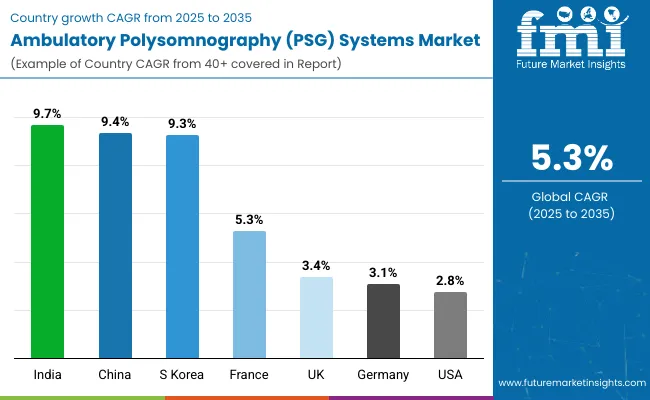
| Countries | Value CAGR (2025 to 2035) |
|---|---|
| United States | 2.8% |
| Germany | 3.1% |
| France | 5.3% |
| United Kingdom | 3.4% |
| China | 9.4% |
| India | 9.7% |
| South Korea | 9.3% |
Germany’s ambulatory polysomnography (PSG) systems market is poised to exhibit a CAGR of 3.1% between 2025 and 2035. The Germany holds highest market share in European market.
Major technological advancements in wearable technology and home sleep testing devices are increasing the ease of use and accessibility of ambulatory PSG systems in Germany. These innovations involve compact, lightweight sensors, among others, and user-friendly interface designs that enable patients to carry out studies on sleep without visiting a hospital; this comfort gives patients confidence and thereby improves compliance.
Besides, artificial intelligence and machine learning are improving data interpretation to a great degree, hence going a long way to diagnose diseases with much accuracy and in time. All these factors contribute to increasing adoption rates among both patients and healthcare professionals in Germany.
Increasing trends in German healthcare are focused on patient-oriented care and, therefore, extend the use of ambulatory PSG systems-an effective solution for the diagnosis of sleep disorders-thus acting as a contributor to market growth.
United States is anticipated to show a CAGR of 2.8% between 2025 and 2035.
The increasing prevalence of sleep disorders is a major growth factors for the ambulatory PSG systems in the United States. Sleep disorders, especially OSA, are projected to affect 22 million Americans; many remain undiagnosed. Contributing factors toward an increase in sleep disorders include obesity, sedentary lifestyles, and increasing levels of stress-all factors prevalent in today's society.
With heightened awareness regarding sleep disorders, more people come forward to seek diagnostic solutions, thus increasing the demand for PSG systems that help in thorough and accurate sleep studies. Ambulatory PSG systems are of particular interest, as they allow patients to undergo monitoring within the comfort of their homes, thus increasing convenience and compliance.
The other driving force is that health care providers increasingly realize the impact of sleep on overall health, and this is prompting them for increased referral to sleep studies. This trend creates a strong market not only for the PSG systems themselves but also for technology and services, stimulating innovation and improving patient outcomes, which extends its use more into clinical and home settings.
China is anticipated to show a CAGR of 9.4% between 2025 and 2035.
In China, the growth of ambulatory PSG systems is driven by growing awareness towards sleep health. Due to rapid urbanization, there is a tendency to work for very long hours and experience tremendous stress among people, which has increased the occurrences of sleep disorders such as insomnia and obstructive sleep apnea (OSA). With more people understanding the quality of sleep, the demand is ever-increasing for diagnostics of sleep effectively.
Government health initiatives, media campaigns, and internet information have increased community awareness of sleep disorders and the risks of not treating conditions like OSA, which include cardiovascular and metabolic diseases. This has resulted in increasing demand for access to home-based sleep testing modality.
Accordingly, ambulatory PSG systems are non-invasive and enable patients to undergo comprehensive studies in the comfort of their homes. Due to convenience, ambulatory PSG systems have become a favorite. Thus, the Chinese market for ambulatory PSG systems will see strong growth due to heightened health awareness.
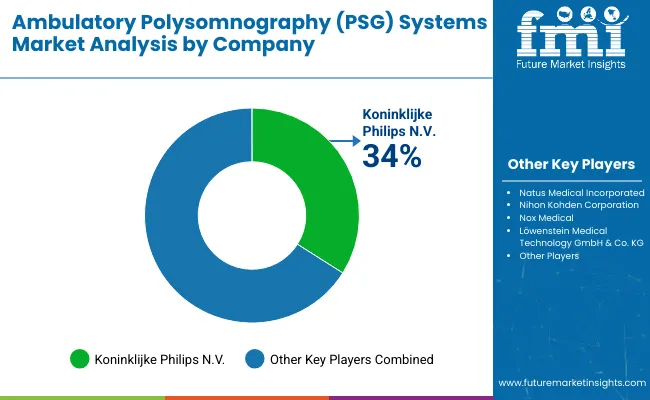
The competition in the ambulatory PSG systems market is fierce, with a large number of manufacturers. Companies are under pressure with increasing demand for advanced sleep diagnostic tools to innovate continuously and upgrade their products.
The manufacturers are heavily investing the development of more sensitive, portable, and user-friendly PSGs. It involves the state-of-the-art technologies: using AI in data analysis, miniaturization for comfort, ease, and adding wireless and cloud features for remote monitoring and disseminating real-time data.
Prominent producers of ambulatory polysomnography (PSG) systems are concentrating on growing internationally in order to increase their revenue and increase the size of their sales footprint in developing nations through the acquisition of regional small players. Manufacturers utilize various key strategies such as partnerships, agreements, product launches, research sponsorship, and strategic collaborations to boost product sales and establish their market presence.
| Report Attributes | Details |
|---|---|
| Market Size (2025) | USD 324.48 Million |
| Projected Market Size (2035) | USD 543.84 Million |
| CAGR (2025 to 2035) | 5.3% |
| Base Year for Estimation | 2024 |
| Historical Period | 2020 to 2024 |
| Projections Period | 2025 to 2035 |
| Quantitative Units | USD million for value and thousand units for volume |
| Products Analyzed (Segment 1) | Up-to 12 Channel PSG Systems, Up-to 24 Channel PSG Systems, Up-to 32 Channel PSG Systems, Above 32 Channel PSG Systems |
| Applications Analyzed (Segment 2) | Obstructive Sleep Apnea, Narcolepsy, Chronic Insomnia, Periodic Limb Movement Disorders, Rapid Eye Movement Sleep Disorders, Sleep Related Seizures, Snoring, Other Applications |
| End Users Analyzed (Segment 3) | Hospital Settings, Independent Sleep Testing Centers, Sleep Clinics, Home Care Settings |
| Regions Covered | North America; Latin America; East Asia; South Asia & Pacific; Western Europe; Eastern Europe; Middle East & Africa |
| Countries Covered | United States, Canada, Brazil, Mexico, Germany, France, United Kingdom, Italy, Spain, China, India, Japan, South Korea, Australia, GCC Countries, South Africa |
| Key Players influencing the Ambulatory PSG Systems Market | Koninklijke Philips N.V., Natus Medical Incorporated, Nihon Kohden Corporation, Nox Medical, Löwenstein Medical Technology GmbH & Co. KG, neurosoft, Cadwell Industries Inc., SOMNOmedics GmbH, Compumedics Limited, Neurovirtual / Sleepvirtual |
| Additional Attributes | Market size in dollar sales and CAGR, share by system type (channels), application trends (OSA, insomnia), end-user mix (clinics, home care), regional dollar sales, competitive dollar sales, tech innovations (wireless, AI), reimbursement and regulatory shifts. |
In terms of product, the industry is divided into up-to 12 channel PSG systems, up-to 24 channel PSG systems, and up-to 32 channel PSG systems and above 32 channel PSG systems.
In terms of applications, the industry is segregated into obstructive sleep apnea, narcolepsy, chronic insomnia, periodic limb movement disorders, rapid eye movement sleep disorders, sleep related seizures, snoring and others applications
In terms of distribution channel, the industry is divided into hospital settings, independent sleep testing centers, sleep clinics, and home care settings
Key countries of North America, Latin America, East Asia, South Asia & Pacific, Western Europe, Eastern Europe and Middle East and Africa (MEA) have been covered in the report.
The global ambulatory polysomnography (PSG) systems industry is projected to witness CAGR of 5.3% between 2025 and 2035.
The global ambulatory polysomnography (PSG) systems industry stood at USD 309.45 million in 2024.
The global ambulatory polysomnography (PSG) systems industry is anticipated to reach USD 543.84 million by 2035 end.
China is expected to show a CAGR of 9.4% in the assessment period.
The key players operating in the global ambulatory polysomnography (PSG) systems industry Koninklijke Philips N.V., Neurosoft, SOMNOmedics AG, Cadwell Industries Inc., Natus Medical Incorporated, Compumedics Limited, Nox Medical, Neurovirtual / Sleepvirtual, Hunan VentMed Medical Technology Co., Ltd., Onera Technologies B.V., BMC Medical Co., Ltd., Medicom MTD Ltd and Cidelec.






Full Research Suite comprises of:
Market outlook & trends analysis
Interviews & case studies
Strategic recommendations
Vendor profiles & capabilities analysis
5-year forecasts
8 regions and 60+ country-level data splits
Market segment data splits
12 months of continuous data updates
DELIVERED AS:
PDF EXCEL ONLINE
Ambulatory Aids Market Size and Share Forecast Outlook 2025 to 2035
Ambulatory Surgical Centers Market Growth - Trends & Forecast 2025 to 2035
Cardiac Ambulatory Monitoring Market Size and Share Forecast Outlook 2025 to 2035
Continuous Ambulatory Peritoneal Dialysis Bags Market Size and Share Forecast Outlook 2025 to 2035
Wireless Polysomnography Market Size and Share Forecast Outlook 2025 to 2035
Systems Administration Management Tools Market Size and Share Forecast Outlook 2025 to 2035
VRF Systems Market Growth - Trends & Forecast 2025 to 2035
Cloud Systems Management Software Market Size and Share Forecast Outlook 2025 to 2035
Hi-Fi Systems Market Size and Share Forecast Outlook 2025 to 2035
Cough systems Market
Backpack Systems Market Size and Share Forecast Outlook 2025 to 2035
Unmanned Systems Market Analysis - Size, Share, & Forecast Outlook 2025 to 2035
DC Power Systems Market Trends - Growth, Demand & Forecast 2025 to 2035
Catheter Systems Market
Reporter Systems Market
Aerostat Systems Market
Cryogenic Systems Market Size and Share Forecast Outlook 2025 to 2035
Air Brake Systems Market Growth & Demand 2025 to 2035
Metrology Systems Market
Fluid Bed Systems Market

Thank you!
You will receive an email from our Business Development Manager. Please be sure to check your SPAM/JUNK folder too.
Chat With
MaRIA